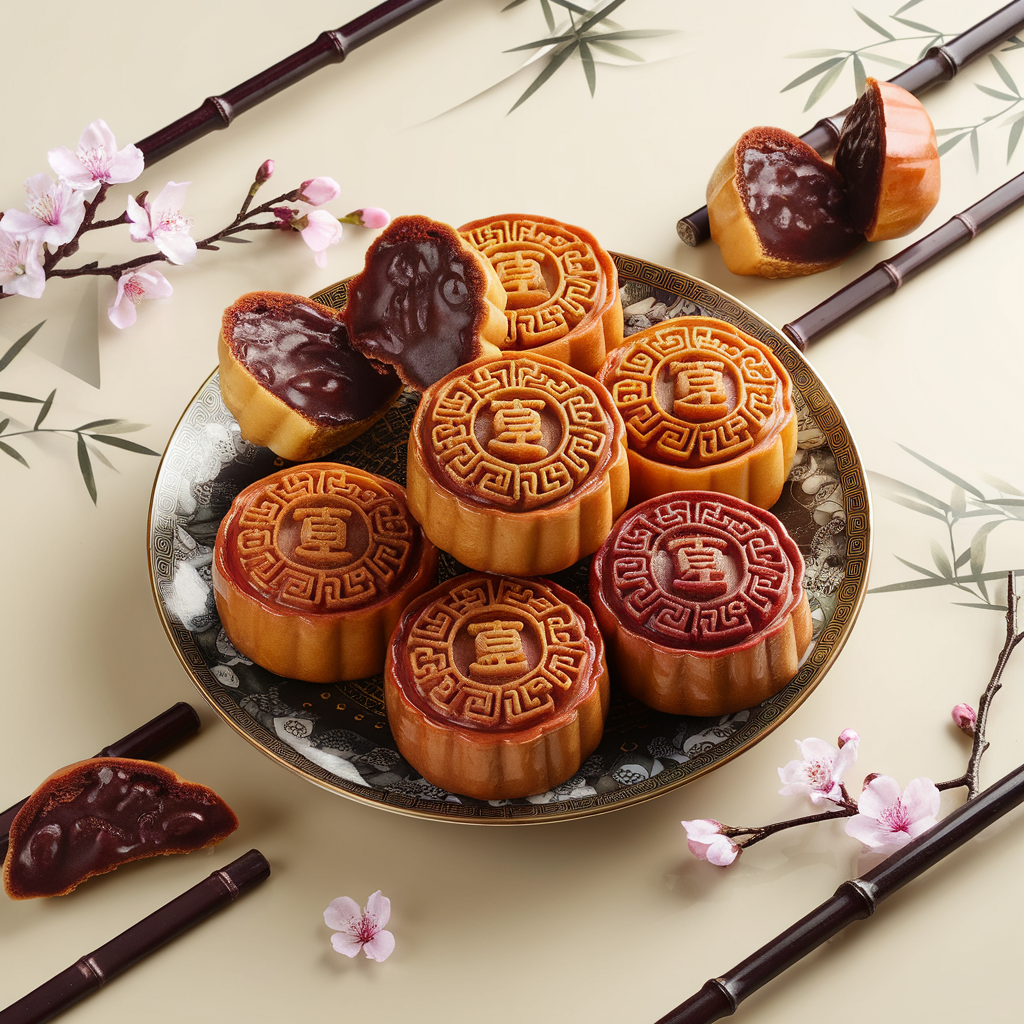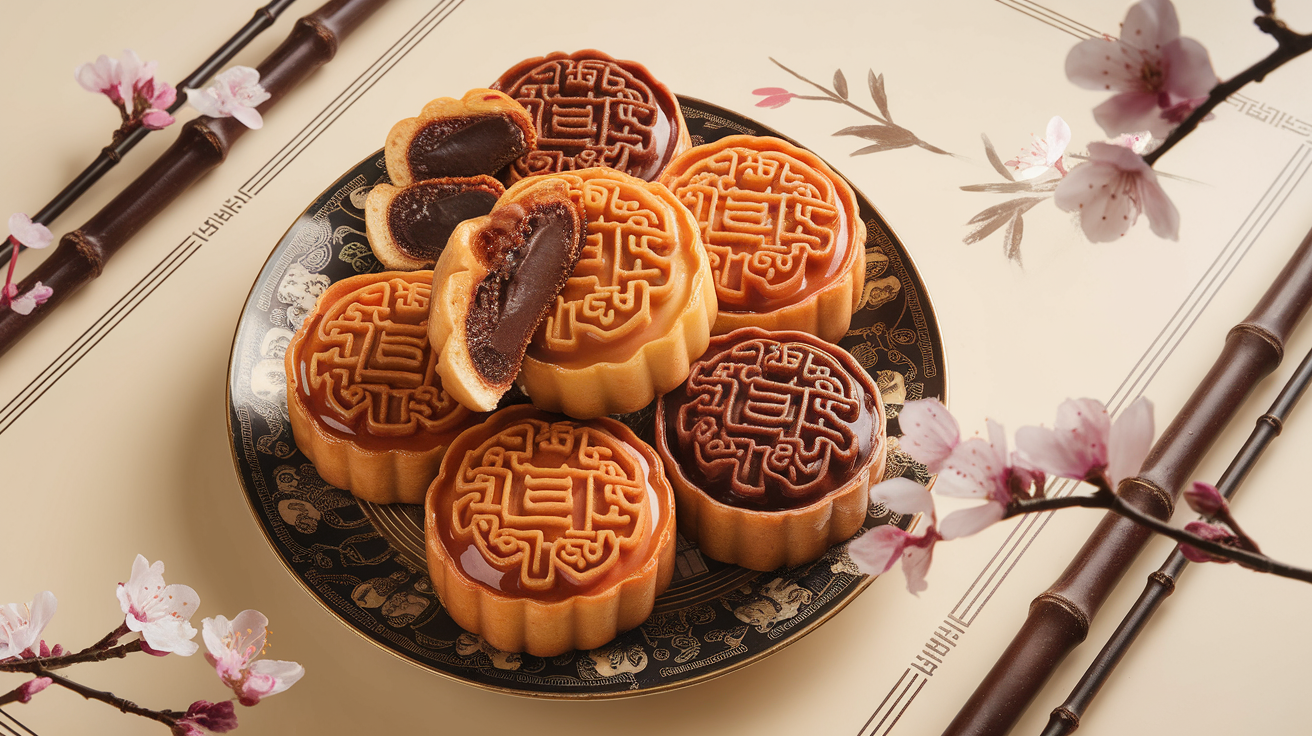A Traditional Chinese Sweet Cake Recipe Celebrated Across Generations
There’s something enchanting about the sight of a golden mooncake—its glossy surface imprinted with intricate Chinese characters or floral designs, its aroma subtly sweet, and its flavor rich with heritage. Among the many variations, Chinese Mooncakes with Red Bean Paste hold a cherished place in Chinese culture and cuisine. They represent not just a dessert but a symbol of unity, celebration, and time-honored tradition.
In this in-depth guide, we’ll explore everything about red bean paste mooncakes—from cultural context and authentic preparation to variations and tips for perfect results. Whether you’re discovering Chinese baking for the first time or looking to recreate the Asian desserts recipes your grandmother once made, this recipe offers an opportunity to honor tradition while enjoying a decadent treat.
🌕 The Symbolism Behind Mooncakes
The Mid-Autumn Festival, also known as the Moon Festival (中秋节 Zhōngqiū Jié), is one of the most significant holidays in China. Celebrated on the 15th day of the 8th month in the lunar calendar, it’s a time for family reunions, lantern lighting, moon gazing, and—most importantly—eating mooncakes.
Mooncakes are circular to represent the full moon, which is a powerful symbol of unity, completeness, and reunion in Chinese culture. It’s common to gather with loved ones and cut a mooncake into slices, sharing both the food and the moment.
Incorporating a red bean paste filling adds another layer of symbolism. Red is a color of luck and happiness in Chinese culture. Red beans themselves are believed to promote good health and are often associated with joy and celebration.
📜 A Brief History of Mooncakes
Mooncakes have been enjoyed for over 700 years, with records dating back to the Yuan Dynasty. Legend has it that they were used to pass secret messages during a rebellion against Mongol rulers. While that tale is a mix of myth and fact, what remains true is the mooncake’s status as a time-honored delicacy.
Today, mooncakes range from traditional Chinese sweet cake recipes to ultra-modern interpretations filled with custard, chocolate, or even ice cream. But sweet red bean paste mooncakes remain a classic, especially for those who appreciate authentic Chinese snacks recipes and nostalgic, home-style desserts.

🫘 What Makes Red Bean Paste So Special?
Red bean paste, or dòushā (豆沙), is made from cooked adzuki beans, sweetened with sugar, and often enriched with a little oil for smoothness. It has a mildly sweet, nutty flavor and a satisfyingly thick, creamy texture. Unlike overly sugary fillings, red bean paste offers subtle sweetness, making it a favorite among lovers of Chinese food desserts.
It’s a staple in many Asian desserts recipes like steamed buns, glutinous rice cakes, and pancakes. When encased in a mooncake, it creates a beautiful contrast with the tender crust—earthy, sweet, and smooth all at once.
🍰 Ingredients for Traditional Red Bean Paste Mooncakes
🌟 For the Mooncake Dough (Skin):
- 150g all-purpose flour
- 90g golden syrup (or substitute with honey or maltose)
- 38g neutral vegetable oil (sunflower or canola)
- 1 tsp alkaline water (helps give the crust its iconic golden-brown hue)
🌟 For the Filling:
- 400g sweet red bean paste (homemade or store-bought)
- Salted egg yolks (optional but traditional—adds savory richness)
🌟 For the Egg Wash:
- 1 egg yolk
- 1 tsp milk or water
🧰 Special Tools:
- Kitchen scale (for precise measurements)
- Mooncake molds (traditional wooden or modern plastic presses)
- Baking tray lined with parchment paper
🧑🍳 How to Make Chinese Mooncakes with Red Bean Paste
Step 1: Make the Mooncake Dough
In a large bowl, combine golden syrup, vegetable oil, and alkaline water. Stir until smooth. Add sifted flour and gently mix to form a soft, pliable dough. Be careful not to overwork it.
Wrap the dough in plastic and let it rest for at least 1 hour at room temperature. This resting period makes the dough easier to work with and gives it a smooth texture.
Step 2: Prepare the Filling
Divide your red bean paste into 30g balls. If you’re using salted egg yolks, halve each yolk and insert into the center of each paste ball. Wrap the red bean paste around the yolk, ensuring it is fully enclosed.
Step 3: Portion the Dough
After resting, divide the mooncake dough into 20g portions. Flatten each into a disc using your fingers or a rolling pin.

Step 4: Shape the Mooncakes
Place a red bean filling ball in the center of the dough disc. Carefully bring the dough up around the filling, pinching and smoothing to seal. Roll gently between your palms to form a ball.
Dust the mooncake mold lightly with flour. Place the dough ball inside and press firmly to imprint the design. Tap the mold to release the mooncake.
Repeat until all mooncakes are shaped and ready.
Step 5: Bake the Mooncakes
Preheat your oven to 180°C (350°F). Place the mooncakes on a lined baking tray and bake for 5 minutes. Remove and let cool for 10 minutes.
Brush lightly with egg wash, then return to the oven for an additional 10–15 minutes, or until golden brown.
Let cool completely. For best results, store mooncakes in an airtight container for 1–2 days. This allows the crust to soften and the flavors to mature.
🥄 Tips for Perfect Mooncakes
- Use a Kitchen Scale: Precision matters in Chinese cake recipes. Consistent weight ensures uniformity in baking and appearance.
- Light Egg Wash: Too much will obscure the intricate mold pattern.
- Let Mooncakes Mature: Freshly baked mooncakes can be dry. Waiting 1–2 days allows oil from the filling to soften the crust.
- Experiment with Mold Shapes: Choose from traditional floral designs or modern symbols of good luck, longevity, and harmony.
🏺 Making Homemade Red Bean Paste
Optional but rewarding, making your own red bean paste gives you control over sweetness and texture.
Ingredients:
- 1 cup dried adzuki beans
- 3 cups water
- ¾ cup sugar
- 1 tablespoon neutral oil
- Pinch of salt
Instructions:
- Soak beans overnight. Drain.
- Simmer in water until soft (about 1.5 hours).
- Drain and blend to a smooth paste.
- Return to pan with sugar, oil, and salt. Stir constantly on low heat until thick and paste-like.
- Cool completely before using.
Homemade paste keeps in the refrigerator for up to a week or can be frozen for longer storage.

🌍 Mooncake Variations Around Asia
🌸 Cantonese-Style Mooncakes
The most recognized version globally. Often filled with lotus paste, nuts, or red bean, sometimes including salted egg yolks.
🧊 Snow Skin Mooncakes
Unbaked and chilled. Made with glutinous rice flour and often filled with custard, matcha, or fruit flavors.
🥜 Five-Nut Mooncakes (五仁月饼)
A mix of walnuts, almonds, sesame seeds, sunflower seeds, and melon seeds bound with syrup. Bold, chewy, and less sweet.
🧁 Modern Fillings
- Matcha and red bean
- Black sesame and mochi
- Chocolate lava
- Cheese and durian
These modern takes reflect evolving tastes but still honor the structure of this Chinese sweet cake.
🎁 Mooncakes as Gifts
Gifting mooncakes is a deeply embedded cultural tradition. They’re given to relatives, friends, employees, and clients as tokens of respect and good fortune.
Luxury mooncake boxes today include:
- Elegant wooden chests
- Gold-trimmed tins
- Silk-wrapped presentation
- Personalized packaging
Adding a handwritten card or a note of Mid-Autumn blessings makes it even more heartfelt.
🧾 Nutritional Snapshot (Per 50g Mooncake, Approximate)
- Calories: 210 kcal
- Protein: 4g
- Carbohydrates: 34g
- Sugar: 18g
- Fat: 7g
- Cholesterol: Varies with egg yolk inclusion
🫖 Best Ways to Serve Mooncakes
Mooncakes are typically sliced into wedges and enjoyed with a cup of tea. Pairing suggestions include:
- Jasmine Tea – light and floral, it balances the sweet filling.
- Oolong Tea – richer, slightly roasted, enhancing the caramel notes.
- Chrysanthemum Tea – a traditional favorite for its digestive properties.
Serve with fresh fruit, nuts, or light savory snacks to balance the richness.
🧡 Preserving Cultural Heritage Through Food
By making mooncakes at home, you’re preserving a culinary tradition that spans continents and centuries. Red bean paste mooncakes are especially meaningful—simple in ingredients but rich in emotion and memory.
Whether you’re gifting them, sharing them, or simply baking to connect with your roots, these red bean pastries are a delicious way to celebrate family, culture, and the sweetness of togetherness.
🏮 Final Thoughts
There’s something magical about crafting these intricate, flavor-packed cakes by hand. They’re more than just desserts—they are stories told through dough and filling, passed down through generations.
If you’re new to Chinese snacks recipes, this is a delicious place to begin. And if you’re reconnecting with old family traditions, mooncakes offer the perfect medium for celebration and memory.
So gather your ingredients, warm your oven, and shape your own Chinese mooncakes with red bean paste—a culinary hug from the heart of China.


